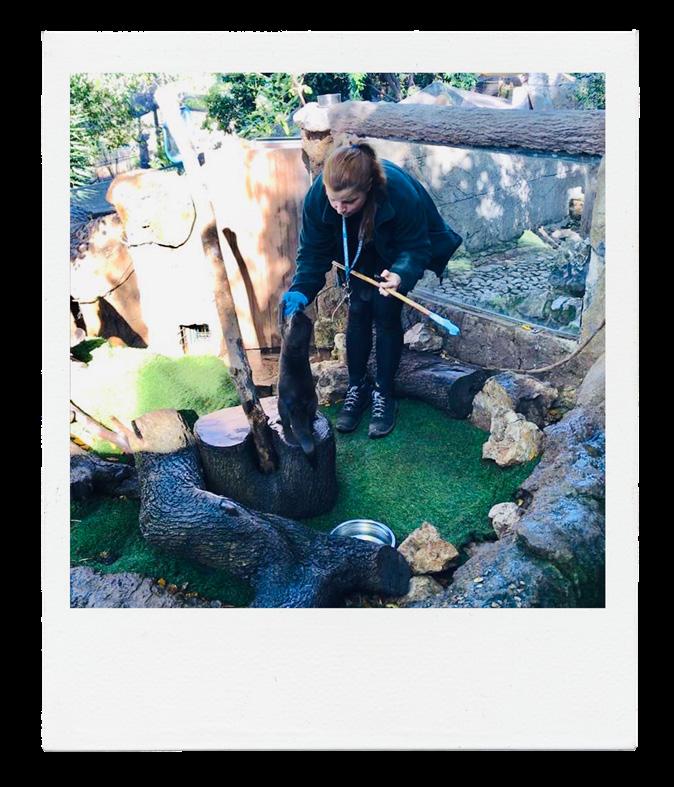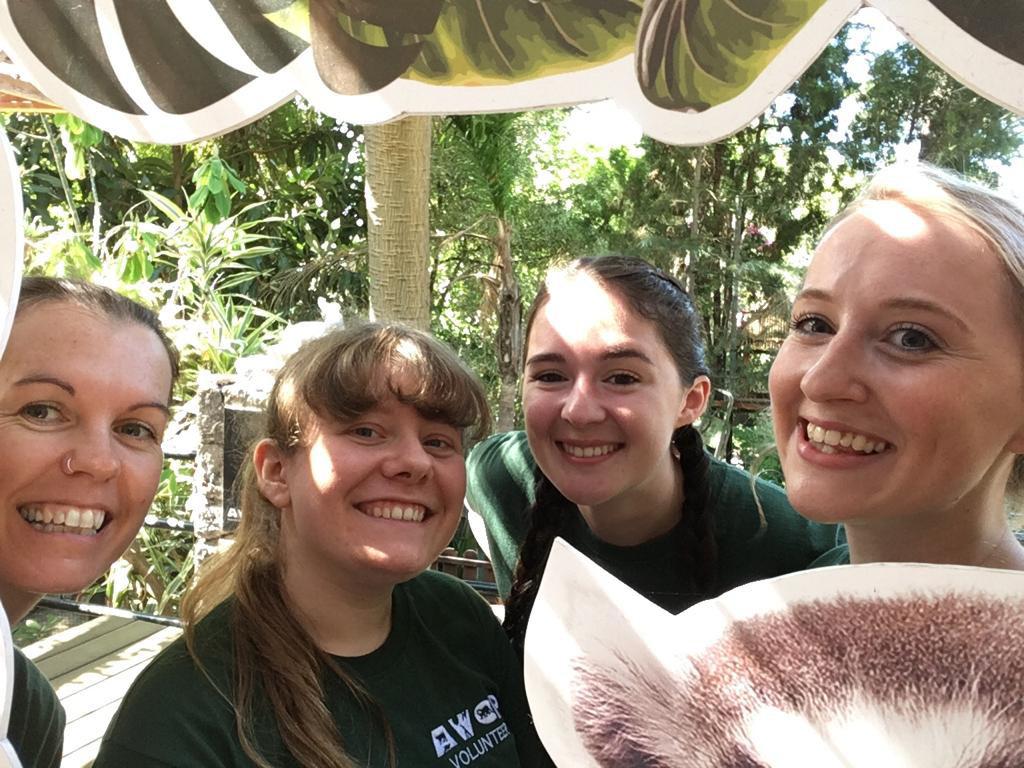
8 minute read
A Zookeeper’s Diary: Meet the Interns
A ZOOKEEPERS
DIARY

Our monthly spotlight on the superstars at the Alameda Wildlife Conservation Park… and their keepers!
BY NIC CAMPBELL
Interns Anna, Kayleigh and Laurie
As routine returns to normal at the Alameda Wildlife Conservation Park (AWCP), the muchvalued volunteers have returned and the park can now celebrate the start of three new internships: Kayleigh, Anna and Laurie. During lockdown, interns and volunteers were not able to help out, but now staff are very excited to have them on the team once again. Kayleigh is a third-year Zoology student from the University of Exeter. She is undertaking a placement year and hopes to work with chimpanzees or lemurs once she finishes her studies. Kayleigh, like the other interns, is getting know all the animals at the park but she has a particular soft spot for the pot-bellied pig, Serranito. Laurie was a veterinary nurse assistant in the UK before heading to Gibraltar. Her plans have taken her on a very different route than expected, but it has worked out for everyone, as she is now part of the AWCP team. There will be lots of opportunity for hands on experience with exotic animals which will help her in her future plans as a veterinary nurse. It’s hard not to love all the animals at the park, but her favourites are the family group of brown lemurs.
Anna is a qualified ecologist with a passion for teaching. This is perfect for the park as they are currently in the process of further developing their education programme. Anna started at AWCP as a volunteer, but she quickly fell in love with the work the park does and all the amazing animals. The staff at the park were delighted to welcome her to the team.
After week four of the internship, the new interns have already settled in nicely. They are involved in all aspects of animal care with every one of the 160 animals at the park, so there is a lot to learn! Each intern is assigned to a keeper with whom they will learn all the necessary skills including proper nutrition, husbandry and enrichment. It is an exciting time for the interns and a challenging one too. The work is very physical; they are outside in all weather and they may have to overcome a few fears along the way! One particular task that gives people the shivers is dealing with bugs.

Insects are not everyone’s cup of tea, but the tamarins and marmosets love them, and they are an essential part of their diet, so the brave new interns have to learn to catch, handle and feed the creepy crawlies to the animals. This can take a bit of practice and quite often there are a few muffled cries of ‘eek!’ along the way, but everyone soon gets the hang of it.
A key part of zoo life is the animal training programmes and interns are encouraged to take an active role in these. Training is essential to the health and well-being of the animals in captivity and can be an important form of enrichment. Many years ago, animals were trained purely for our own entertainment, but today zoos use a technique called ‘operant conditioning’, part of which is ‘positive reinforcement’, to train animals in order to undertake medical procedures or carry out husbandry routines without the need of capturing and restraining the animal. Restraining any animal is of course highly stressful for the animal and can sometimes lead to further complications, so positive reinforcement allows the animal to be comfortable with the situation as much as possible. It is the animals’ choice to participate or not, they are never forced. They should enjoy the training sessions, so they get lots of nice treats for their efforts. An example of a husbandry behaviour is ‘crate training’. An animal can be trained, using lots of positive reinforcement, to sit quietly and comfortably in a crate for transportation to the vet, whereas previously the animal may have been caught using a net and put into the crate or carrier. There are obvious hazards with this type of capture and restraint so it’s easy to see why zoos have embraced operant training techniques.
11 12 10 9 8 7 6
1 3 2 Head Keeper Steve Bryant and myself (Primate 5 4 Keeper Nic Campbell) wanted to further develop the training program for the animals at the zoo. Steve has a wealth of animal training knowledge and experience from working in Monkey World in the UK and other larger zoos. We worked closely together to identify which animals were most in need of training. But how do you decide which animals need training? In theory, since training is a highly enriching activity all the animals should participate, however, in reality, time and people power are common restrictions. After an hour or two of serious thinking Steve and I came up with a plan. It is important that training is planned out well, from beginning to end, with a clear goal for each training session and also an ‘end result’. Keepers also try to do the training at a similar time each day, so the animals can expect it, and some even look forward to it!
9 10 11 12 1 3 2 The cottontopped tamarins were an obvious 8 7 6 5 4 first choice for training. These ‘punk rocker primates’ would need to be caught with a net if they ever needed vet attention, and this is incredibly stressful, and potentially dangerous for the small monkeys. Cotton-tops are critically endangered in their native Colombia and are part of a zoo breeding programme. The park needs to ensure these little monkeys are in tip-top condition and living a stress-free life whilst in their care. At the back of their enclosure they have a tunnel system which links their indoor enclosure with the outside. The tamarins happily move from area to area by themselves. Steve and Nic decided to stop or ‘station’ them in the tunnels and reward
them with their favourite treats for doing so. Since the tamarins were familiar with the tunnels it didn’t take them long to know the routine and hang around a little longer. The tunnel has two sliding doors and when closed it can be removed. This acts like a carry-case which can be taken to the vets. The next step was to slowly, bit by bit, close the doors. This took a couple of weeks of patience and perseverance, but the hard work paid off when they were able to close both doors and have a content, relaxed little monkey sitting eating their treat.
After lunch 11 12 1 (keepers’ 10 2 lunch, that 9 3 is!) the 8 4 Long-tailed 7 6 5 macaques get a training session. There are two groups of Long-tailed macaques at the AWCP and although they are an adorable troop of monkeys, none of the keepers want to get too close or personal with them. So, in order to carry out routine husbandry, the keepers must shift the monkeys around. ‘Marvin’s group’, which consists of the dominant male, Marvin, an old boy Macho, mischievous Abu and gorgeous little old Teapot, are an easy group to shift. Lead by their stomachs, they will happily shift into another enclosure for the promise of food. But things are a little different in the other troop. Dobby, the dominate male, Peachy-Lou is the feisty female and endearing Elvis make up the other group of this Asian species of macaque. This group was highlighted by Nic as a in need of (immediate!) training because more often than not, Elvis will refuse to play the shifting game. No matter what

tasty treats were on offer, if any keeper was standing at the door he would refuse to move. It is understandable since in monkey society there is a strict hierarchy and poor Elvis is at the lower end of the pile. He is therefore not so keen to move into a smaller enclosure (even for a short while) with the two dominant animals.
So, how do you train the lowest ranking animal to do something that they are not so keen on doing? The first step is to remove the dominant animals from the equation. Both Dobby and Peachy-Lou will be kept busy in their own training programme at the back of the enclosure with one keeper, which means Elvis can relax and enjoy the treats offered to him without fear of repercussions from the other two. Bit by bit he has taken the bold steps to move through the sliding door into the other enclosure and all without the stress and fear from previous times. This is the most rewarding part of the programme for the keepers. To see the progress of the animals and to know that they are participating because they want to and not because they have to is great to see. The keepers often find their ‘trainees’ waiting expectantly for the next session, before they have even begun!
Any animal can be part of the training programme. Phase two will include the African grey parrots, the brown lemurs and the adorable otters Dixie and Trixie. What this space for more animal training antics at the AWCP.
To find out more about the work at the AWCP, find them on Facebook, Instagram & Twitter or visit: www. awcp.gi.










